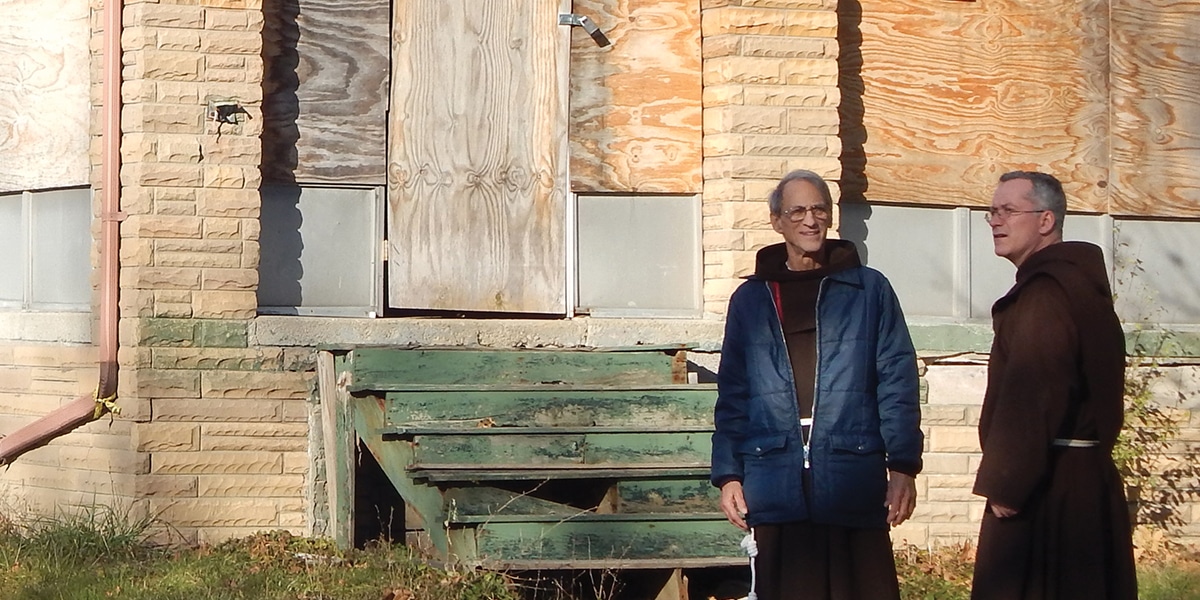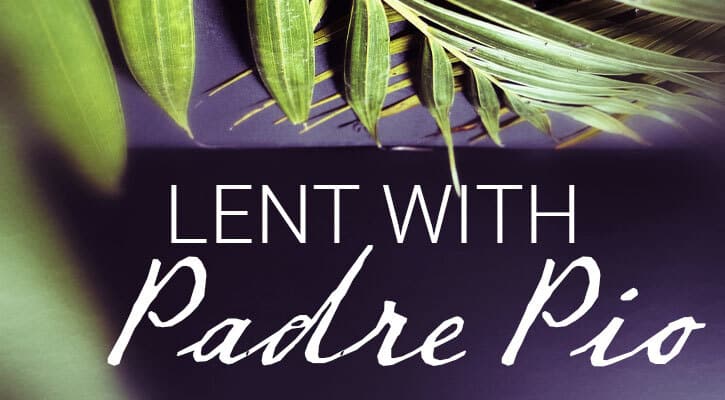Following in the footsteps of St. Francis, three friars have set up shop in the poorest neighborhood in Detroit.
There are four signs on the building announcing the presence of friars.
“One thing I learned working in evangelization,” says Alex Kratz, OFM, “is to let people know where you are.” So every few yards, there’s a sign marking the site of the newest Franciscan friary in Detroit: St. Moses the Black. The last time anyone lived in this former rectory on Oakman Boulevard was 20 years ago. Since October 2017, it’s been home to Friar Alex and fellow St. John the Baptist Friars Louie Zant and Maynard Tetreault.
In a city rebounding from its past, the friars are part of a neighborhood that’s been left behind. Next door is a food pantry that sees brisk traffic. On the street in back, eight houses are boarded up or so structurally unsound they’re caving inward. With windows broken or shuttered, nearby factories are lifeless and desolate.
A few blocks away is another sign, this one marking the boundary of Highland Park. It not only has the highest crime rate in Detroit—46 crimes per 1,000 residents—but one of the highest in America. Here, your chance of becoming a victim of either violent or property crime is one in 22. If poverty has a ground zero, this is the place.
For Friars Maynard, Alex, and Louie, the natural question is, “Why here?” And just as important, “Why now?”
Abandonment
The “now” part seems like divine providence. “Last year was the 50th anniversary of the riots in Detroit,” says Friar Maynard, referring to a tsunami of violence that swept the city in 1967, leaving 43 people dead and 2,000 buildings destroyed. For Friar Alex, race and inequity converged in recent, deadly confrontations between African Americans and police officers. “All of this came crashing into my prayers,” he says.
In March, Friar Alex suggested an expansion of their Detroit-area presence into an underserved neighborhood that was predominantly black. Although he has been in Detroit since 1999, serving as director of evangelization for the archdiocese for eight of those years, he admits he circumvented these poorer areas. “Whenever I drive, I take the highway. I bypass miles and miles of this,” he says, waving an inclusive hand. “I felt a bit conflicted that I kind of avoided this whole area,” including the adjacent city of Highland Park, “which is even poorer than Detroit.”
A quote from a class at St. Bonaventure University—”Faith must have social consequences”—nudged Friar Alex forward. “My studies kept echoing in my head,” he says. “Social location is part of our Franciscan charism. When we’re in a location where the poor are, it changes our witness.”
Father Mark Soehner, former pastor of St. Aloysius in Detroit, knew the area well. During his time as director of postulants, he worked in the cluster of four parishes that served some of these neighborhoods and taught the Rite of Christian Initiation of Adults (RCIA), Friar Alex says. The two talked a lot in general about problems and discussed the possibility of refurbishing a room for worship in the former rectory at St. Moses the Black, which was eventually formed by the merger of three of those parishes.
“We say Detroit has suffered ‘demolition by neglect,'” Friar Alex adds. “We only have a few Catholic parishes in the city. There’s a feeling of abandonment among Catholics in Detroit. Institutionally, the Church has pulled out.”
Spirit at Work
A pastoral letter called “Unleash the Gospel, ” released in June 2017 by Archbishop Allen Vigneron, was a call to evangelization. “His plan is to have the religious evangelize the city,” Friar Alex says. “I’d say we’re on the cutting edge of evangelization. It’s right down our alley.”
After the provincial council endorsed his plan, it took some looking and searching to find the right place, Friar Alex notes. “If I was going to invite friars in, I didn’t want to be in a structurally dangerous building with a slumlord,” which eliminated a number of prospects. Finally, he says, “the Holy Spirit guided me to [St. Moses the Black].”
The pastor of the church, Father J.J. Mech, also serves as rector of the nearby Cathedral of the Most Blessed Sacrament and pastor of Our Lady of the Rosary. His associate in all three locations, Father Patrick Gonyeau, is also central regional coordinator of evangelization for the Archdiocese of Detroit. The very busy Father Patrick speaks for the community when he says, “There’s such an excitement about the Franciscans being here.”
Indeed, “People have been very welcoming,” says Friar Louie, a regular at morning Mass.
“The parish is older, but there are kids in catechism class,” according to Friar Maynard. “There’s always hospitality after Mass. They have a lively liturgy and a great choir. All they need is people.”
For Detroit-born Friar Maynard, this was a homecoming. “Our parish [Visitation] was a mile from here. These were my old haunts.” He remembers Oakman Boulevard as a nice, middle-class neighborhood, more upscale than his own.
This summer, his ministry in Galveston, Texas, ended when the province returned Holy Family Parish to the Archdiocese of Galveston-Houston. “This [Detroit proposal] didn’t really come about until April. I heard about the potential of this place. I think our presence among [marginalized] people is important. I think it is a tiny gesture of hope,” he says.
Cleaning Up
St. Moses the Black spans most of a block on the boulevard. It’s a fortress of a building, with arched doorways and a vaulted atrium that serves as a vestibule and meeting space. Near the main door is an imposing painting of the church’s patron saint, the fourth-century slave who gave up a life of banditry to become a desert monk and an apostle for nonviolence.
Up the steps and off to the right is the friary, which until recently served as the hub and storage facility for St. Moses the Black Food Pantry. Now the pantry is housed in the former school next door, where Friar Louie is a volunteer.
He visited the future friary after returning from missionary service in Jamaica, eager to continue his service work. “I was just interested in going someplace where I could be useful,” he says, such as Pittsburgh or Cincinnati. “[Friar] Alex asked me if I might be interested in coming to Detroit, interacting with people in neighborhood projects.”
When he first arrived, he recalls that “we came through a rolling metal door” that blocked homeless people from sleeping on the steps, turning the rectory into a bunker. Inside, there were boxes all around and the first floor was used as storage for the parish food pantry. “It needed some cleaning up,” he adds, but despite the clutter, they saw the possibilities in the 92-year-old rectory.
“This place hadn’t been lived in in 20 years,” says Friar Maynard, whose eagle eye as provincial building coordinator does not miss much. “When we did the walk-through and saw plaster coming down, we knew it needed some care.”
The parish fixed the plumbing and replaced the roof. Electrical work is an ongoing project. Most of the 17 doors needed sanding and lock repairs, and most would not close, which is a typical issue as old buildings settle.
Looking, Listening
By the time he moved here in October 2017, Friar Louie says, “Things were very livable.” The furnishings, mostly donated, have the plain but serviceable look of bygone friaries. The addition of Internet was a must, but TV screens are absent by design.
Slowly but surely, Friars Maynard and Louie have whittled the to-do list to a manageable size and are changing focus. Now they’re assessing the needs of their neighbors and quietly making their presence known.
“People carry a lot of burdens,” Friar Alex says of the locals. “Some of them live on their own. One of the things I’ve been thinking of doing is asking people waiting at the food pantry if they’d like to be prayed with.”
One day he was praying the rosary on the sidewalk at 6 a.m. while wearing his habit. “I think being visible and being in the neighborhood is important,” he explains. “A young guy was catching a bus for his job at a potato chip factory. He did a double take and said, ‘You’re medieval.’ I explained to him what friars are about.”
As for Friar Maynard, he says, “I’m not putting out my shingle” for sacramental ministry just yet. His goal for this first year is to listen and learn what people need the most and follow what the bishop wants.
He is encouraged by what he’s seen. “I was happy to hear about us going into the city. A lot of people are working on a comeback for Detroit,” he says, including Mayor Mike Duggan, “who has promised to do more for neighborhoods. There are many hopeful signs.”
In the middle of Highland Park, four of those signs, lettered in brown, are attached to this building.








